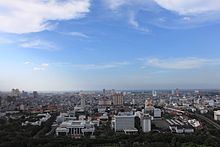Time zone WIB (UTC+7) Area 146.7 km² | Website utara.jakarta.go.id Population 1.422 million (Mar 2010) | |
 | ||
Weather 26°C, Wind W at 13 km/h, 92% Humidity Points of interest Dunia Fantasi, Sea World Indonesia, Atlantis Water Adventure, Ocean Dream Samudra, Waterbom Jakarta | ||
A day in north jakarta
North Jakarta (Indonesian: Jakarta Utara) is one of the five cities (kota) of Jakarta, Indonesia. North Jakarta contains the entire coastal area within Jakarta Special District. In North Jakarta, an area at the estuary of Ciliwung river was the main port for the kingdom of Tarumanegara, which later grew to become Jakarta. Many historic sites and artefacts of Jakarta can be found in North Jakarta. Both ports of Tanjung Priok and historic Sunda Kelapa are located in the city. The city, which had 1,645,312 inhabitants at the 2010 Census, has its administrative centre in Tanjung Priok.
Contents
- A day in north jakarta
- Map of North Jakarta North Jakarta City Jakarta Indonesia
- Persitara pride of north jakarta wmv
- History
- Tourism
- Subdistricts
- Stadium
- Education
- References
Map of North Jakarta, North Jakarta City, Jakarta, Indonesia
North Jakarta contains some of Jakarta's original natural mangrove forests. As the city has developed, some of this mangrove forest was converted into urban areas. However, a reforestation project aimed at planting mangroves within an area of 400 hectares has already been enacted and is scheduled to be finished in 2012. The main goal of the project is to minimized abrasion in the coastal area, especially around the Pantai Indah Kapuk area.
North Jakarta is bounded by Java Sea to the north; Bekasi to the east; West Jakarta, Central Jakarta and East Jakarta to the south; and Tangerang to the west.
Persitara pride of north jakarta wmv
History
The city of Jakarta grows from the area in what is now North Jakarta. In the 5th century, at the mouth of the Ciliwung-Angke River, grew the port city Sundapura (now near Tugu, Jakarta and Bekasi), which is the main port for the Kingdom of Tarumanegara under the leadership of King Mulawarman.
During the 16th century, the city, which covers only the area of what is now North Jakarta, was known as Jayakarta. The system of government in Jayakarta has been amended several times, including change of rulers, and change of the administrative area. This area consists of three forms of government: First, the city government which is controlled directly by the Lord of Jayakarta (the area of which is located in what is now the Port of Angke). Second, the state government controlled by leaders inferior to the Lord of Jayakarta (the area of which is located in what is now Pasar Ikan and Kota. Third, the worldwide government (the area of which is located in what is now Tanjung Priok.
At the beginning of the 17th century, the area was controlled by Chinese and other native people who later have to submit to the Dutch East Indies.
In 1854, the Law of Comptabuliteit 1854 divided the Jakarta Bay area into three categories: the Voorsteden (the suburbs), Regentschap Batavia (the Regency of Batavia) and private areas (supervised by the Department of Security - Afdeling I)
Government system changed again in 1905. After the formation of Gemeente Batavia, the area around Jakarta Bay is transformed into Batavia District which includes the Onderdistrict (Subdistrict) of Penjaringan, Tanjung Priok, Meester Cornelis and Bekasi. Meanwhile, Tanjung Priok is controlled by Haven Directie Koninklijke Paketvaart-Maatschappij.
When Japan entered into the region, the form of the government changed into Shiku (district level), and so North Jakarta was divided into districts such as Shiku Penjaringan, Shiku Tanjung Priok and Shiku Bekasi.
After the formation of the Unitary Republic of Indonesia on August 17, 1945, Jakarta Bay is divided into several administrative regions, namely Kewedanan Penjaringan, Tanjung Priok and Bekasi. These three kawedanan are controlled by the Mayor of Jakarta Raya, which was part of West Java.
In 1957, after the formation of the Kotapraja Jakarta Raya, the area of Jakarta Bay was transformed into the Kotamadya of Jakarta Utara or "City of North Jakarta".
Tourism
The government of North Jakarta planned for a rehabilitation of tourism in North Jakarta under the project of 12 Coastal Tourism of North Jakarta (Indonesian: 12 Jalur Destinasi - Wisata Pesisir Jakarta Utara). The chosen 12 destinations are:
Subdistricts
North Jakarta is subdivided into 6 subdistricts:
Stadium
On May 28, 2014 the ground breaking of a new stadium in 12.5 hectares area has been done to replace old Lebak Bulus Stadium which is demolished for Jakarta Mass Rapid Transit project. The new stadium project will cost Rp1.2 trillion ($103.2 million) and is provided with a 50,000-seat modern main stadium, 2 training fields and include a water park, a running track, a bike path, an exhibition hall and other recreational facilities surrounding the stadium. The project is predicted will be finished in end of 2017.
Education
International schools:
